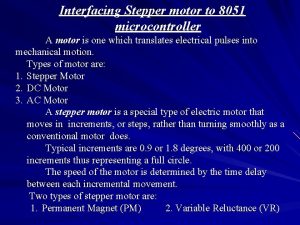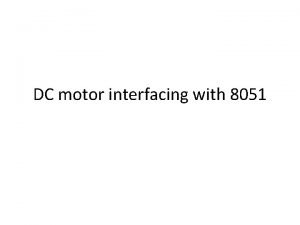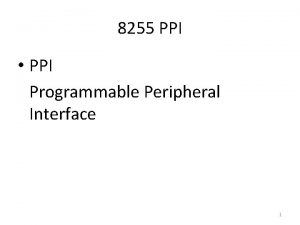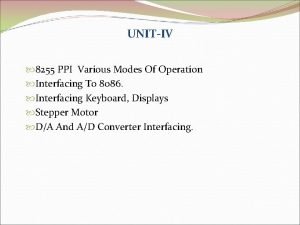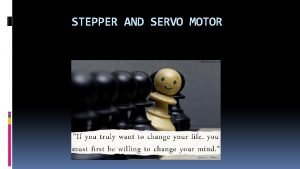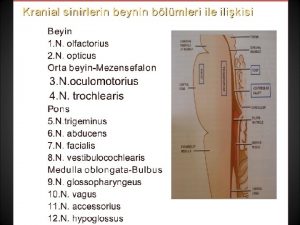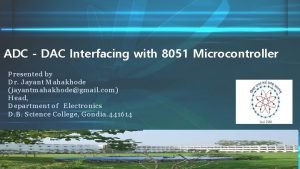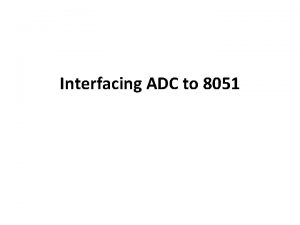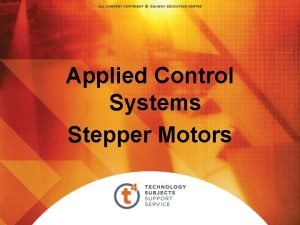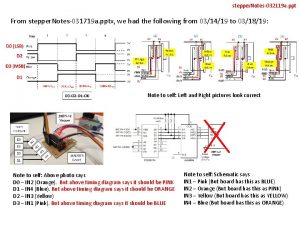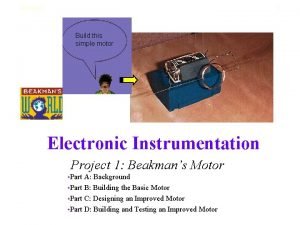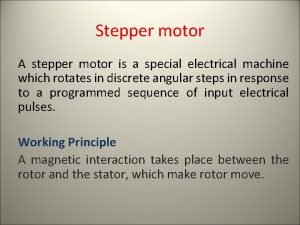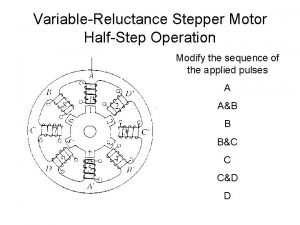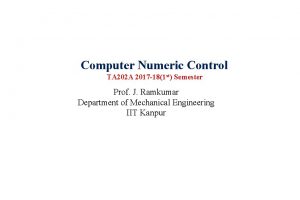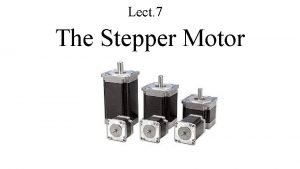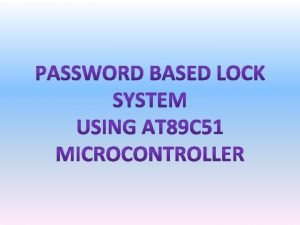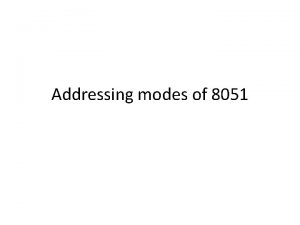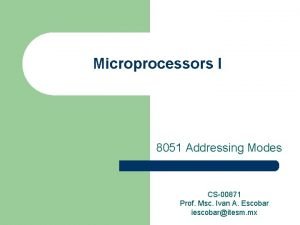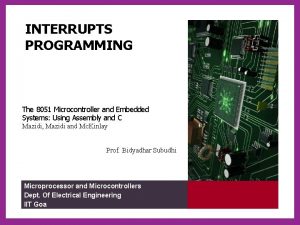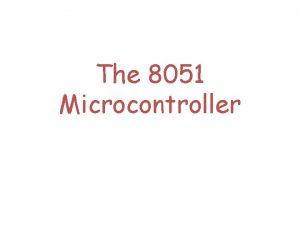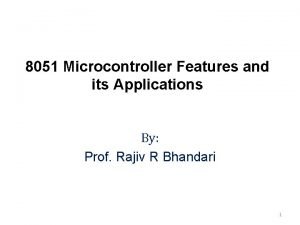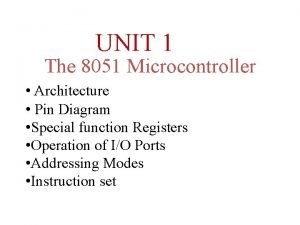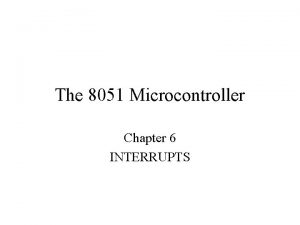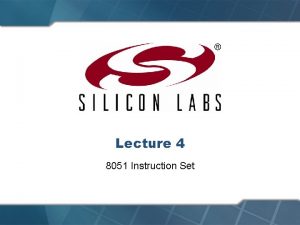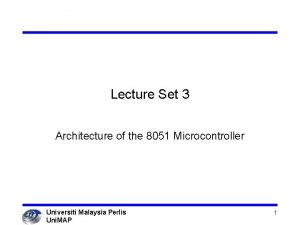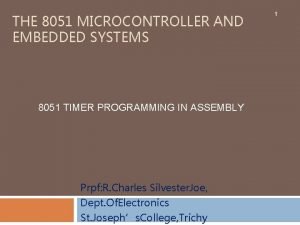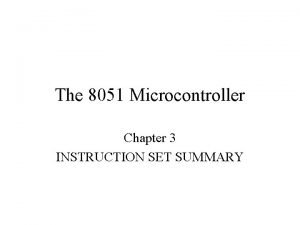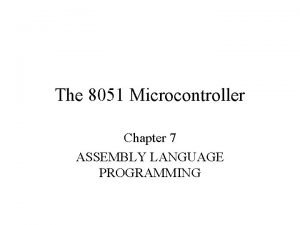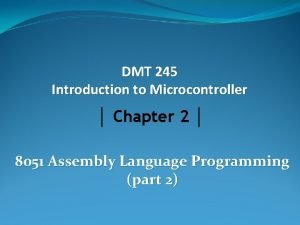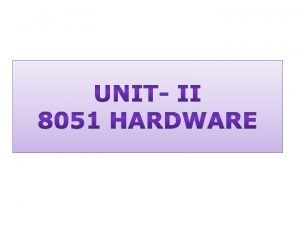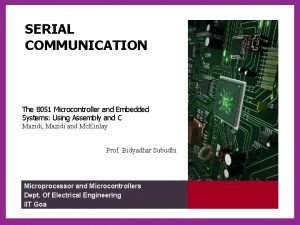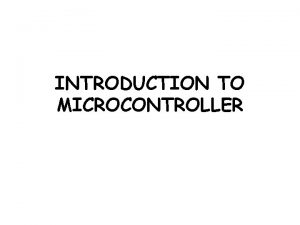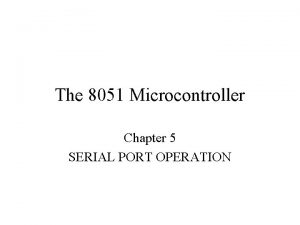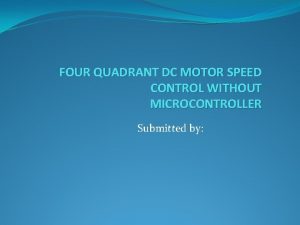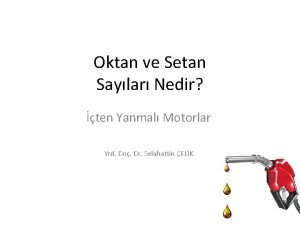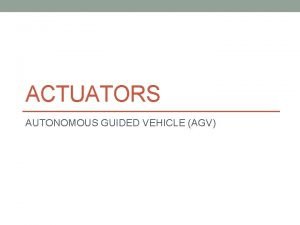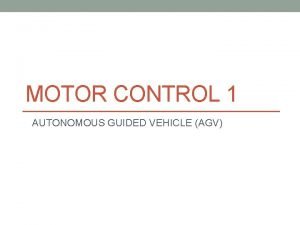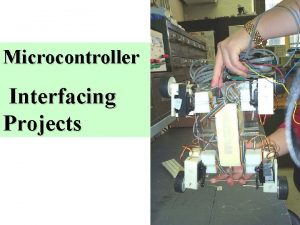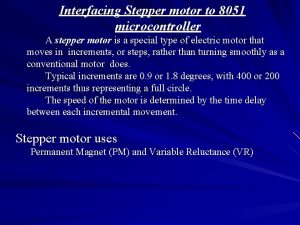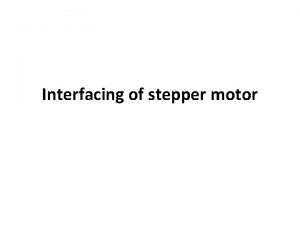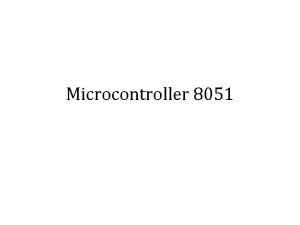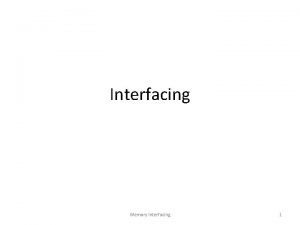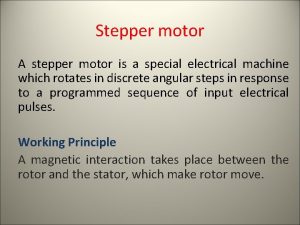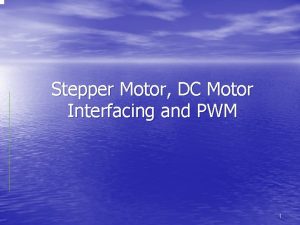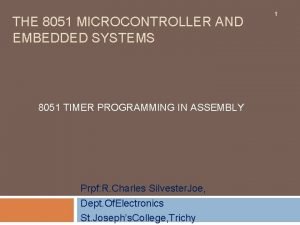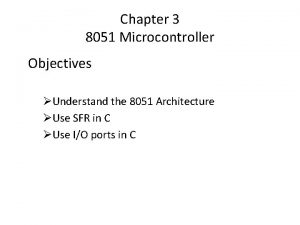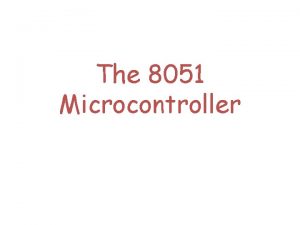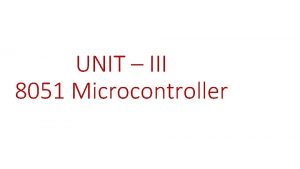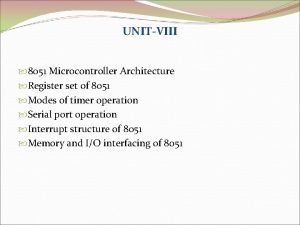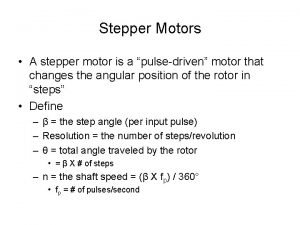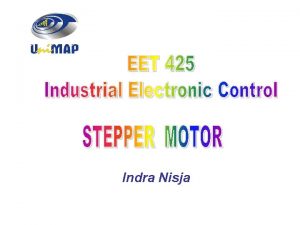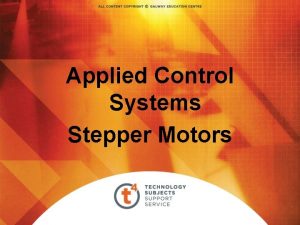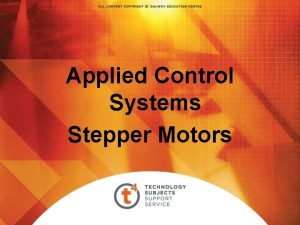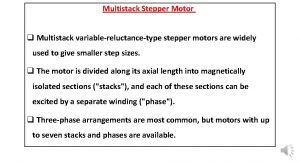Interfacing Stepper motor to 8051 microcontroller A motor

































![#include<reg 51 xd 2. H> void delay(unsigned int); main() {unsigned char Flr[9] = {0 #include<reg 51 xd 2. H> void delay(unsigned int); main() {unsigned char Flr[9] = {0](https://slidetodoc.com/presentation_image/3ed3420c706ddc638ab6ad2a19f2317b/image-34.jpg)

![Cur. Flr = Req. Flr; //Update current floor P 0 = Flr[Cur. Flr]; //Clear Cur. Flr = Req. Flr; //Update current floor P 0 = Flr[Cur. Flr]; //Clear](https://slidetodoc.com/presentation_image/3ed3420c706ddc638ab6ad2a19f2317b/image-36.jpg)








- Slides: 44

Interfacing Stepper motor to 8051 microcontroller A motor is one which translates electrical pulses into mechanical motion. Types of motor are: 1. Stepper Motor 2. DC Motor 3. AC Motor A stepper motor is a special type of electric motor that moves in increments, or steps, rather than turning smoothly as a conventional motor does. Typical increments are 0. 9 or 1. 8 degrees, with 400 or 200 increments thus representing a full circle. The speed of the motor is determined by the time delay between each incremental movement. Two types of stepper motor are: 1. Permanent Magnet (PM) 2. Variable Reluctance (VR)

Motor Moves Each Time a Pulse is Received Can Control Movement (Direction and Amount) Easily Can Force Motor to Hold Position Against an Opposing Force

Construction Permanent Magnet Rotor – Also Called the Shaft Stator – Surrounds the Shaft – Usually Four Stator Windings Paired with Center-Tapped Common Known as Four-Phase or Unipolar Stepper Motor

Construction (con’t) Center Tapped Common

Moving the Rotor Unstable Stable Rotor will ALWAYS seek a stable position.

Single-Coil Excitation - Each successive coil is energised in turn.

Two-Coil Excitation - Each successive pair of adjacent coils is energised in turn.

Interleaving the two sequences will cause the motor to half-step 8 step sequence = normal 4 step + wave drive 4 step.


Single-Coil Excitation Two-Coil Excitation Interleaved Single- and Two-Coil Excitation Half-Stepping


How Far Does It Move? Step Angle – Arc Through Which Motor Turns With ONE Step Change of the Windings – Varies With Model of Stepper Motor (Depending on the number of teeth on stator and rotor) – Normally in Degrees – Step angle = 360/No. of Steps per Revolution – Commonly available no. of steps per revolution are 500, 200, 180, 144, 72, 48, 24

How Fast? Revolutions per Minute (RPM) The top electromagnet (1) is turned on, attracting the nearest teeth of a gear-shaped iron rotor. With the teeth aligned to electromagnet 1, they will be slightly offset from electromagnet 2. The top electromagnet (1) is turned off, and the right electromagnet (2) is energized, pulling the nearest teeth slightly to the right. This results in a rotation of 3. 6° (1. 8’) in this example. The bottom Electromagnet (3) is energized; another 3. 6° (1. 8’) rotation occurs. The left electromagnet (4) is enabled, rotating again by 3. 6° (1. 8’). When the top electromagnet (1) is again enabled, the teeth in the sprocket will have rotated by one tooth position; since there are 25(50) teeth, it will take 100 (200) steps to make a full rotation in this example.

Common Stepper Motor Types

Drivers May Need a Driver Circuit – Same Problem as Relays – May Draw Too Much Current Types – Transistor Drivers Usually a Darlington Pair – Darlington Arrays – Can Build It Yourself

Using Transistors for Stepper Motor Driver

Applications: Used in Ø In instrumentation such as watches, clocks, etc. ØComputer peripherals such as card readers, teleprinters, teletypes, dot matrix printers, etc. ØRobotics

//Program for stepper motor interface #include <REG 51 x. D 2. H> void delay (unsigned int x) /* Delay Routine */ { for(; x>0; x--); return; } void main ( ) { unsigned char Val, i; P 0=0 x 00; Val = 0 x 11; for (i=0; i<4; i++) { P 0 = Val; Val = Val<<1; /* Val= Val>>1; for clockwise direction*/ delay (500); }}

Interfacing DC motor to 8051 microcontroller

DC Motors Only One Winding Two Connections: + and – Reversing Polarity Reverses Motor Move Continuously Cannot Determine Position

Characteristics: RPM – No Load: Maximum RPM With No Load on Shaft Given in Data Sheets – Loaded: Actual Maximum When Loaded Not in Most Data Sheets Voltage Range – Speed Increases With Voltage on a Given Motor Current Draw – Data Sheet Rating Is With Nominal Voltage and No Load – Increases With Load Speed Decreases With Load

DC Motor Rotation (Permanent Magnet Field)

Bi-Directional Control Can Change Polarity With a Little Work H-Bridge Is Simplest Method – Uses Switches (Relays Will do)

Controlling Speed Depends On – Load – Voltage – Current Can Control Power By Changing (Modulating) Width of Pulse to Motor – Wider Pulse Faster Speed – Narrower Pulse Slower Speed Note: Doesn’t Work With AC Motors – AC Motor Speed Depends on AC Frequency (CPS)



#include<REG 51 x. D 2. H> sbit inr=P 3ˆ2; //speed increment switch sbit dcr=P 3ˆ3; //speed decrement switch main() {unsigned char i=0× 80; //i has initial speed value=half speed = 80 H P 3=0×ff; //configure P 3 to accept switches while(1) {if (!inr) //if increment is pressed {while (!inr); //wait till key is released if (i>10) //if speed is more than minimum i=i-10; //increase the DC motor speed, by decreasing the count } //end of if if (!dcr) //if decrement is pressed {while (!dcr); //wait till key is released if (i<0 xf 0) //decrease the DC motor speed, by increasing the count } //end of if P 0=i; //output the value to port P 0 for speed control } } //end of while and main

Hex keypad Placement of keys on port lines Connection of Hex keypad to 8051

#include<reg 51 xd 2. h> #include<intrins. h> #include"lcd. h" unsigned char rows, columns, result; unsigned char temp = 0; void delay() //delay subroutine {unsigned int i; for(i=0; i<=20000; i++); } //display subroutine to convert hex to ASCII and display on LCD void Display() {if(result>0 x 09) {result += 0 x 37; //if value is greater than 9, add 37 H Write. Char(result); } else {result += 0 x 30; //if value is between 0 to 9, add 30 H Write. Char(result); } } //end of display subroutine

void Key. Scan() //Keypad subroutine {again: columns = 0 x 0 e; //make P 1. 0 low rows = 0 x 04; //4 rows to check result = 0 x 0; //Key value starts at ‘ 0’ next: P 1 = columns; //output columns CY = 1; //make CY = 1 for next rotation columns <<= 1; //rotate ‘columns’ left temp = P 0; //store in temp = (temp & 0 x 0 f); if(temp != 0 x 0 f); //if key pressed {rot: temp>> = 1; if(!CY) {Clr. Lcd(); //key found return; } else {result += 1; //next column; key value is incremented goto rot; } }

else {result += 0 x 04; //for next row; 4 is added to key value rows - -; //decrement number of rows if(rows = = 0) goto again; //start from beginning else {goto next; } }} void main() {P 0 = 0 xff; //make as input port P 1 = 0 x 00; Init. Lcd(); //initialize LCD Write. String("KEY PRESSED=") while(1) {Key. Scan(); //call keypad subroutine Write. String("KEY PRESSED=") Display(); //display the value }}

ELEVATOR INTERFACE TO 8051

![includereg 51 xd 2 H void delayunsigned int main unsigned char Flr9 0 #include<reg 51 xd 2. H> void delay(unsigned int); main() {unsigned char Flr[9] = {0](https://slidetodoc.com/presentation_image/3ed3420c706ddc638ab6ad2a19f2317b/image-34.jpg)
#include<reg 51 xd 2. H> void delay(unsigned int); main() {unsigned char Flr[9] = {0 xff, 0 x 00, 0 x 03, 0 xff, 0 x 06, 0 xff, 0 x 09}; unsigned char Req. Flr, Cur. Flr = 0 x 01, i, j; P 0 = 0 x 00; P 0 = 0 xf 0; while(1) {P 1 = 0 x 0 f; Req. Flr = P 1|0 xf 0; while(Req. Flr == 0 xff) Req. Flr = P 1|0 xf 0; //Read Request Floor from P 1 Req. Flr = ~ Req. Flr; if(Cur. Flr == Req. Flr) //If request floor is equal to current floor {P 0 = Flr[Cur. Flr]; //Clear Floor Indicator P 0 = P 0|0 xf 0; //Enable again continue; //Go up to read again }

else if (Cur. Flr > Req. Flr) //If current floor is > request floor { i = Flr[Cur. Flr] - Flr[Req. Flr]; //Get the no of floors to travel j = Flr[Cur. Flr]; for(; i>0; i- -) //Move the indicator down {P 0 = 0 x 0 f 0 | j; j- -; delay(25000); }} else //If Current floor is < request floor {i = Flr[Req. Flr] - Flr[Cur. Flr]; //Get the no of floors to travel j = Flr[Cur. Flr]; for(; i>0; i- -) //Move the indicator Up {P 0=0×f 0 | j; j++; delay(25000); }}
![Cur Flr Req Flr Update current floor P 0 FlrCur Flr Clear Cur. Flr = Req. Flr; //Update current floor P 0 = Flr[Cur. Flr]; //Clear](https://slidetodoc.com/presentation_image/3ed3420c706ddc638ab6ad2a19f2317b/image-36.jpg)
Cur. Flr = Req. Flr; //Update current floor P 0 = Flr[Cur. Flr]; //Clear the request indicator P 0 = P 0|0 xf 0; } //end of while } //end of main void delay(unsigned int x) {for(; x>0; x- -); }

Temperature Transducer

The following are the Port connections for 89 C 51 ED 2 and ICL 7109(ADC) i/p : P 0 is connected to data lines of the ADC o/p : P 2 lower nible ADC control lines o/p P 1. 1 ---- relay control. o/p : P 2. 0 --- LBEN active low o/p : P 2. 1 --- HBEN active low o/p : P 2. 2 --- CE active low o/p : P 2. 3 --- RUN active high o/p : P 2. 4 --- RELAY active high i/p : P 1. 0 --- Status of ADC: - ready when low

An electrical transducer is a sensing device using which a physical, mechanical or optical quantity to be measured is transformed into electrical signal (voltage or current) proportional to input. PT 100 is a temperature transducer which converts change in temperature to change in resistance. Change in resistance is represented by change in voltage using a resistance bridge. A RTD (Resistance Temperature Detector) is a temperature sensing device whose resistance increases with temperature. Resistance of RTD is calculated by Wheat stone bridge. Vo = VEX( R 3/[R 3+R 4]) – VEX(R 2/[R 1+R 2]) R 4 = ((R 1(VEX-Vo) - R 2 Vo)R 3) / (R 1 Vo + R 2 (VEX + Vo)) If R 1=R 2=R 3=100Ω and bridge ix excited at VEX = 1. 8 V Then, R 4= ((100(1. 8 -Vo) – 100*Vo)100) / (100*Vo + 100(1. 8+Vo)) Analog output of resistance bridge is converted to digital output which is read by 8051 microcntroller, which in-turn controls the power to the heating element. It uses 12 -bit dual slope integrating ADC (ICL 7109).

# include <reg 51 xd 2. h> #include "lcd. h" unsigned int Adc; unsigned char Low_adc, High_adc, relay; sbit ce=P 2^2, rc=P 1^1, LBEN=P 2^0, HBEN=P 2^1, soc=P 2^3; read_adc() {unsigned char status; soc = 1 ; // Start conversion of ADC status = P 1; //Read status of ADC while((status & 0 x 01) != 0 x 01) {status = P 1; } ce = 0; // Enable outputs LBEN = 0; // Activate B 1 to B 8 outputs Low_adc = P 0; // Read lower byte of ADC and place in R 0 LBEN = 1; // Deactivate B 1 to B 8 outputs HBEN = 0; // Activate B 9 to B 12 and POL, over range outputs High_adc = P 0; // Read higher byte of ADC High_adc = High_adc & 0 x 0 F;

HBEN= 1; // deactivate B 9 to B 12 and POL, over range outputs ce = 1; // Disable outputs soc = 0; // Stop conversion of ADC} main() { float Temp, Vol, Res; unsigned char Temp 1, Temp 2, Temp 3; P 0 = 0 x. FF ; // Make port 0 as input P 2 = 0 x. FF ; // Make port 2 as high now the relay is on. rc = 0 ; // switch OFF relay soc = 0 ; // STOP conversion of ADC while(1) {read_adc(); //Read ADC Adc = High_adc; Adc <<= 8; Adc = Adc | Low_adc; if( (Adc > 0 x 656) && (relay != 0)) //IF > 0 x 0656 Switch OFF relay {Clr. Lcd(); Write. String("RELAY OFF");

rc = 0 ; relay = 0; } else if ( (Adc < 0 x 656) && (relay!= 1)) //IF less than 0 x 05 B 9 Switch ON relay { Clr. Lcd(); Write. String("RELAY ON"); rc = 1 ; relay = 1; } Vol = -((Adc/10)*0. 000488); //voltage before amplifier Res =((100*(1. 8 -Vol)-100*Vol)*100) /(100*Vol +100*(1. 8+Vol)); // Resistance Value Res = Res - 100; Temp = Res/ 0. 384; Temp 1 = Temp; Temp 2 = 0 x 30 + (Temp 1 / 0 x 0 A); Temp 3 = 0 x 30 + (Temp 1 % 0 x 0 A);

Goto. XY(0, 1); Write. String("Temperature "); Write. Char(Temp 2); Write. Char(Temp 3); Write. String("'C"); } }

 Stepper motor interfacing with 8051 program
Stepper motor interfacing with 8051 program Dc motor interfacing with 8051
Dc motor interfacing with 8051 Intel 8255 programmable peripheral interface
Intel 8255 programmable peripheral interface Interfacing adc with 8086 using 8255
Interfacing adc with 8086 using 8255 Stepper motor interfacing with 8085
Stepper motor interfacing with 8085 Stepper motor interfacing with 8085
Stepper motor interfacing with 8085 Interfacing of adc and dac with 8051
Interfacing of adc and dac with 8051 Interfacing adc with 8051
Interfacing adc with 8051 Adc dac interfacing with 8051
Adc dac interfacing with 8051 Step motors and control systems
Step motors and control systems A stepper motor hdl application must include
A stepper motor hdl application must include Stepper motor ppt
Stepper motor ppt 2262021
2262021 Stepper motor construction and working
Stepper motor construction and working Stepper
Stepper Half step operation of stepper motor
Half step operation of stepper motor Dc servo motor
Dc servo motor Stepper motor diagram
Stepper motor diagram Stepper ko hindi mein kya kahate hain
Stepper ko hindi mein kya kahate hain Addressing modes of 8051
Addressing modes of 8051 8051 addressing modes
8051 addressing modes 8051 ie register
8051 ie register Addressing modes of 8051 microcontroller
Addressing modes of 8051 microcontroller 8051 block diagram
8051 block diagram Timers and counters in 8051
Timers and counters in 8051 Features of 8051 microcontroller
Features of 8051 microcontroller Pin diagram of 8051 microcontroller
Pin diagram of 8051 microcontroller 6 interrupts in 8051
6 interrupts in 8051 Clr c instruction in 8051
Clr c instruction in 8051 Internal memory organization of 8051 microcontroller
Internal memory organization of 8051 microcontroller 8051 delay calculator
8051 delay calculator Instruction set of 8051
Instruction set of 8051 Assembly language programming 8051
Assembly language programming 8051 Rotate and swap instruction in 8051
Rotate and swap instruction in 8051 1980
1980 8051 serial communication programming
8051 serial communication programming Advantages of microcontroller
Advantages of microcontroller Timer in microcontroller
Timer in microcontroller In mode 0, serial communication is
In mode 0, serial communication is Four quadrant dc motor speed control with microcontroller
Four quadrant dc motor speed control with microcontroller Stepper faydaları
Stepper faydaları Galileo found for steeper inclines
Galileo found for steeper inclines Agv stepper motors
Agv stepper motors Agv stepper motors
Agv stepper motors Cse 325
Cse 325
